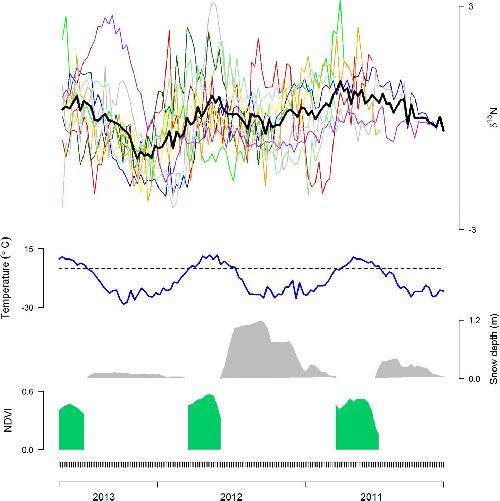Analysis of hairs from muskoxen in the Arctic tundra indicates they had limited amounts of forage available and relied heavily on body stores during snow-heavy winters, according to a study published April 20, 2016 in the open-access journal PLOS ONE by Jesper Bruun Mosbacher from the Arctic Research Centre at Aarhus University, Denmark, and colleagues.
Like other northern hooved animals, female muskoxen are more likely to bear calves when they have ample fat and protein stored for the winter, a state that strongly influences population demographics. Continuously growing tissues, like hair, provide a fairly long-term record of animal diets in the form of δ15N, a nitrogen isotope that varies seasonally in many grass-fed animals, and muskoxen guard hairs grow continuously for several years. The authors of this study clipped guard hair samples from the rumps of 10 muskoxen and used isotope analysis to reconstruct their diets in Northeast Greenland over the previous two and a half years, achieving a resolution of about nine days.
The researchers found that the diets of muskoxen were closely linked to changes in the temperature and snow depth. While summer diets were similar from year to year, winter diets varied widely, likely caused by large variations in the snow depth between winters. In particular, increased δ15N values were seen in muskoxen guard hair in winters with heavy snowfall. This indicated that the muskoxen had very limited access to forage and relied more heavily on their body stores to get through these extreme winters.
 Muskox dietary history and ambient environment.
Muskox dietary history and ambient environment.
Shown in the top is the muskox (Ovibos moschatus) dietary history inferred from the standardized nitrogen isotope ratios (δ15N) in guard hairs from 10 muskox cows and their mean (black line), covering approximately 2.5 years with a temporal resolution of app. 9 days. Below the stable isotope ratios are shown the ambient environmental conditions: Mean air temperature (°C), mean snow depth (m) and meadow productivity (NDVI) from the study area in the 9-day intervals. The guard hair dietary chronology matched the local environmental fluctuations, and included almost three full summer (high δ15N ratios) and winter periods (low δ15N ratios).
Compared to summer diets, winter diets exhibit more pronounced inter-annual variation. Credit: Mosbacher et al.
Though only 10 muskoxen were included, the study shows that isotope levels in hair may be used as an indicator of winter diet quality and body condition. Due to the close link between body condition and the production of calves, the authors suggest that this method may help in the monitoring of difficult-to-access animal populations, particularly in areas undergoing marked changes in climate.
Jesper Mosbacher notes: "With climate changing twice as fast in the Arctic than elsewhere, and with declining muskox populations in the Arctic, understanding how a changing climate is affecting a key species in the Arctic is crucial. This study provides a unique and novel insight into how changing temperature and snow conditions affect the diet of muskoxen, and thereby, ultimately, the production of new calves."
source: PLOS